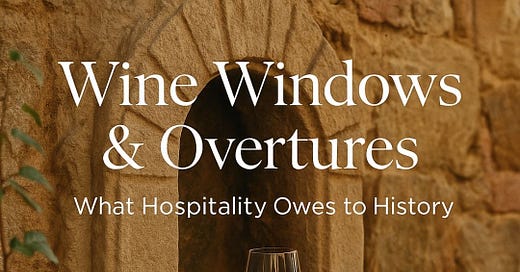Last week, actor and Italy enthusiast Stanley Tucci stirred a quiet storm. In a since-deleted Instagram post, he lamented the rise of “negative wine tourism” — overcrowded towns, tour buses, and long lines clouding his Italian summer escape. His words landed clumsily, especially coming from someone whose fame helped shape the very Tuscan dreamscape so many now seek.
The backlash was swift. Locals, sommeliers, and slow travelers called out the hypocrisy: isn’t this the cost of romanticizing Italy on a global stage? But rather than pile on, I found myself thinking about what Tucci might’ve missed — and what all of us, as lovers of wine and culture, often forget:
That hospitality, at its best, is not about performance. It’s about memory, generosity, and quiet continuity.
And nothing captures that better than Italy’s buchette del vino — the tiny “wine windows” of Florence.
A Gentle History of Wine Windows
These little architectural portals — no bigger than a breadbox — first appeared during the Black Death. To limit contact, Florentine wine merchants would pass flasks through the stone walls of palazzos directly to customers. One knock, a coin placed on a small tray, and out came the wine.
Centuries later, the same windows reopened during the COVID-19 pandemic. Locals used them to serve espressos, gelato, or Prosecco — not as a gimmick, but as an elegant act of endurance.
And now, the spirit of the wine window is crossing oceans. Just this month, the Buchette del Vino Association helped install a wine window in Manhattan, the first of its kind outside Italy. Nestled into the Upper West Side, this tiny arch now serves Chianti and Vin Santo — poured hand to hand, through centuries of tradition, right in the heart of New York City.
A wine window is the opposite of spectacle. It asks for nothing but a pause. It doesn’t demand you “book an experience.” It simply offers wine through stone, with trust and grace.
The Tourism We Create
Wine tourism is a double-edged pour. On one hand, it sustains rural economies, lifts up small producers, and connects people to place. On the other, it risks turning heritage into hashtag. A sleepy hill town becomes a photo op. A quiet cellar becomes a crowded itinerary stop.
But here’s the real question: who gets to decide when it’s “too much”? And why does our frustration so often get directed at the traveler, rather than the host — or the systems shaping these experiences?
Perhaps what Tucci meant (clumsily) is that we are all complicit. In our thirst for the perfect sip and sunset, we sometimes forget to see the people behind the wine — or the centuries of resilience they carry.
Overtures, Not Just Offerings
An overture isn’t just a musical prelude. It’s a gesture — of welcome, of connection. And in wine, overtures matter. Whether it’s a pour through a buchetta or a quiet hello at a family-run cantina, these small moments shape how we experience place.
I’ve seen it in Temecula, California, too. Amid the tour vans and party buses, there are still winemakers who lead their own tastings, who prune their own vines, who remember your name when you return. Not every region gets it right — but the good ones know that hospitality is a story, not a script.
A Different Kind of Pour
So no, I don’t believe the answer is fewer tourists. I believe the answer is better hospitality.
Not louder, not flashier — just more human.
The wine window reminds us: it’s possible to serve with intention. To pour without pretense. To open a door, or a window, not for status, but for kinship.
As wine lovers, we can ask more of the places we visit. And as hosts, we can offer more than just the glass.
We can offer overtures — the kind that linger long after the wine is gone.
✨ If this spoke to you…
Pour it forward. Share this piece with someone planning a wine trip or shaping a tasting room — and if you're seeking something more intentional, I help design wine itineraries and tasting events that honor story, place, and soul.. Let's keep the conversation honest — and the windows open.


